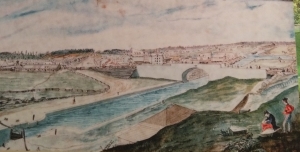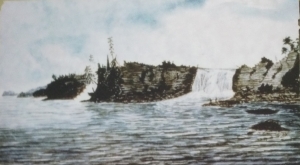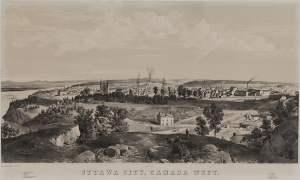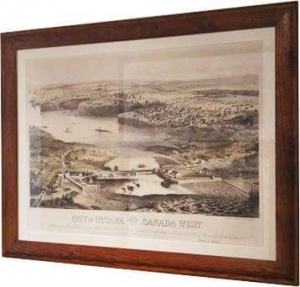Before Photography: Images of Bytown in its Early Days | Avant la photographie : Images de Bytown à ses débuts
By: Emily M. (Youth Council Member)
Photographs have become essential in recording the present and the past. However, before photography, what did early settlers use to record what was around them?
Within the Bytown Museum, there are lithographic prints and watercolours drawn up by surveyors of the Rideau Canal. These prints by Thomas Burrowes, a surveyor and employee of the canal, and Edwin Whitefield, a North American landscape artist, tell a compelling story of what Bytown looked like during its early years.

Born in England in 1796, Thomas Burrowes enlisted with the Royal Sappers and miners at age seventeen which eventually led to his posting to Canada in 1815. In his formal study, he learned practical exercises in defense, bridge making, and drawing maps. In 1826, he was posted to Ottawa as an assistant to

Colonel John By, commander of the Rideau Canal project. He was an assistant overseer on the project, helping in the Union Bridge construction and surveying the Ottawa River. During his work in Ottawa, Burrowes created watercolours that depict the Bytown area. Discovered in 1907 in Detroit, Michigan, some reproductions of Burrowes’ watercolours can be found on the first floor of the Bytown Museum with descriptions of the canal.
Burrowes most likely painted as a hobby rather than as a part of his surveying report. Nonetheless, his watercolours are useful for historians as they record and capture the Ottawa River and the early construction of the Rideau Canal.
Walk up to the second floor of the Museum and you will see two framed lithographic prints of Bytown/Ottawa, created by Edwin Whitefield. Whitefield was born on September 22nd 1816. In 1842 he had begun experimenting with lithography. Lithography is a printing process where a wax drawing is applied to stone, such as limestone. The ink is then applied and gathers where the wax has not touched, which is then transferred to the paper, producing a lithographic print. Around 1847-1852, Whitefield had travelled across the United States and Canada and produced prints showing Northern rural landscapes.

One of these is located at the Bytown Museum, Ottawa City, Canada West (Lowertown) (P436), where we see a view of Bytown landscape. Whitefield arrived in Bytown in 1854, this print was completed in 1855 and depicts key places such as the modern day Parliament Hill, Rideau Canal, and the Commissariat Building, which houses the Bytown Museum. Also captured was the city’s prominence in commerce, the Catholic cathedral, and industrial power.

This print was originally paired with the westerly view of Ottawa which focusses on trade and features the Chaudière Falls.
Facing it is a print by Stent & Laver Architects, City of Ottawa, Canada West, (P586). Created circa 1859, this print depicts the city seen from above the Chaudière Falls looking down on the Ottawa River. Architectural firms would often hire artists anonymously to complete their prints, and Edwin Whitefield was likely the artist that rendered this print as well.
Both Whitefield’s and Burrowes’ works are useful to historians as they capture the landscape, features, and overall spirit of Bytown in its early days.
par Emily M. (conseil des jeunes)
Les photographies sont essentielles pour enregistrer le présent et le passé. Cependant, avant l’invention de la photographie, qu’utilisaient les premiers colons pour documenter leur environnement?
La collection du Musée Bytown comprend des lithographies et des aquarelles réalisées par les arpenteurs ayant collaboré à la construction du canal Rideau. Ces gravures de Thomas Burrowes, arpenteur, et d’Edwin Whitefield, peintre paysagiste nord-américain, montrent à quoi ressemblait Bytown au moment de sa fondation.

Né en Angleterre en 1796, Thomas Burrowes se joint au Régiment royal des sapeurs et mineurs à l’âge de 17 ans, ce qui le conduira à travailler au Canada en 1815. Pendant ses études, Burrowes a suivi des exercices pratiques de défense, il a appris à faire des ponts et à dessiner des cartes. En 1826, on l’envoie à Bytown comme assistant du colonel John By, qui dirige la construction du canal Rideau. Il participe comme aide-contremaître au projet, aidant à ériger le pont Union (aujourd’hui appelé pont de la Chaudière) et produisant des levés de la rivière des Outaouais. Durant le temps passé à Bytown, Burrowes exécute des aquarelles illustrant la région.
Découvertes en 1907 à Detroit, au Michigan, certaines reproductions des aquarelles de Burrowes sont présentées au premier étage du Musée Bytown, accompagnées de descriptions du canal.

Il est probable que Burrowes ait pratiqué la peinture comme loisir plutôt qu’en vue de son rapport d’arpentage. Néanmoins, ses aquarelles servent aux historiens comme documents sur la rivière des Outaouais et le début de la construction du canal Rideau.
Au second étage du Musée, vous verrez deux lithographies de Bytown/Ottawa encadrées, réalisées par Edwin Whitefield. Whitefield est né le 22 septembre 1816. En 1842, il commence à faire de la lithographie. Dans ce procédé d’impression, on dessine avec un crayon de cire sur de la pierre, comme du calcaire par exemple. On verse ensuite de l’encre qui s’étend là où il n’y a pas de cire, puis on transfert la partie encrée sur du papier. Vers 1847-1852, Whitefield voyage aux États-Unis et au Canada, et il produit des gravures illustrant les paysages nordiques ruraux.

L’une de ces gravures, intitulée Ville d’Ottawa, Canada Ouest (Basse-Ville), se trouve au Musée Bytown (P436). Elle représente la ville de Bytown, où Whitefield est arrivé en 1854. Cette gravure achevée en 1855 illustre des lieux importants tels que l’actuelle colline du Parlement, le canal Rideau et l’édifice du commissariat qui abrite le Musée Bytown, ainsi que cathédrale catholique. On y voit aussi l’importance du commerce dans la ville et la puissance de l’industrie.
Cette gravure faisait à l’origine partie d’une paire de lithographies montrant le secteur ouest de Bytown axé sur le commerce, ainsi que les chutes de la Chaudière.

En face de la gravure de Whitefield se trouve une gravure de Stent & Laver Architects intitulée Ville d’Ottawa, Canada Ouest (P586). Créée vers 1859, cette vue montre la ville du haut des chutes de la Chaudière et plonge jusqu’à la rivière des Outaouais. Les firmes d’architectes engageaient souvent des artistes qui, de façon anonyme, achevaient leurs gravures. Il est très probable qu’Edwin Whitefield ait produit le rendu de celleci.
Les œuvres de Whitefield et de Burrowes sont très utiles aux historiens, car elles témoignent du paysage et des caractéristiques de Bytown au moment de sa fondation ainsi que de l’esprit qui y régnait.
